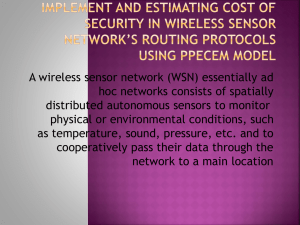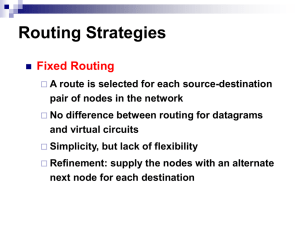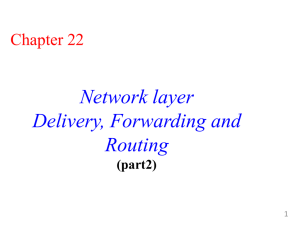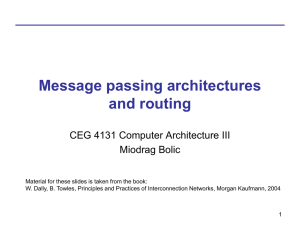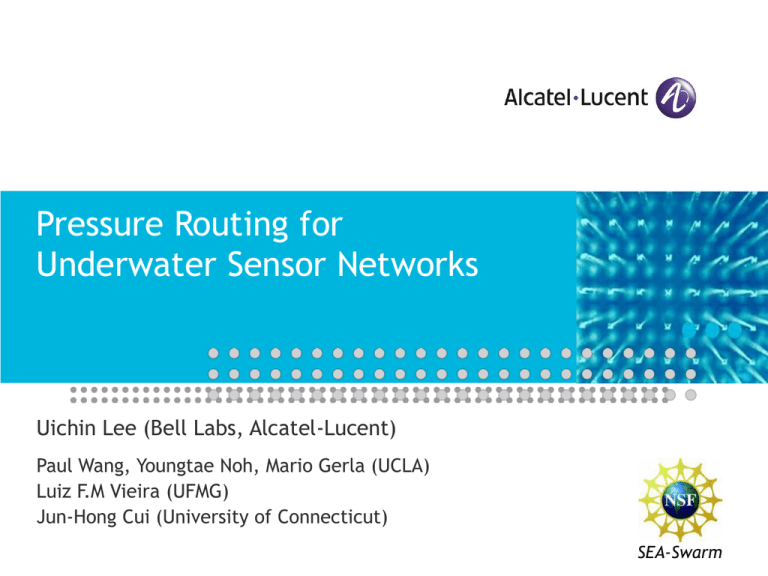
Pressure Routing for
Underwater Sensor Networks
Uichin Lee (Bell Labs, Alcatel-Lucent)
Paul Wang, Youngtae Noh, Mario Gerla (UCLA)
Luiz F.M Vieira (UFMG)
Jun-Hong Cui (University of Connecticut)
SEA-Swarm
SEA-Swarm (Sensor Equipped Aquatic Swarm)
Monitoring center deploys a large # of mobile u/w sensors (and sonobuoys)
Mobile sensors collect/report sensor data to a monitoring center
Monitoring center performs data analysis including off-line localization
Short-term “ad hoc” real-time aquatic exploration: oil/chemical spill
monitoring, anti-submarine missions, surveillance etc.
GPS
Radio
signal (WiFi)
Data analysis
Sonobuoy
Monitoring center
Example: UCSD Drogues
Acoustic
Communications
Acoustic modem
Pressure (depth) sensor
Depth control device
+ Other sensors
Pictures from: http://jaffeweb.ucsd.edu/node/81
2 | Pressure Routing for Underwater Sensor Networks | March 17, 2010
Copyright © 2010 Alcatel-Lucent. All rights reserved.
Problem Definition
SEA-Swarm challenges:
Acoustic comms: energy hungry (~W), low bandwidth (<100kbps), long
propagation delay (3x10^3 m/s)
Node mobility due to water current (<1m/s)
Ground sensor routing protocols do not work well in underwater
High protocol overheads, e.g., route discovery (flooding) and/or maintenance
Not suitable for bandwidth constrained underwater mobile sensor networks
(collision + energy consumption)
3D geographical routing (stateless, local) has the following limitations:
Requires distributed underwater localization (+location service)
Efficient recovery from a local maximum (like face routing) is not feasible
(Durocher et al., ICDCN’08)
3 | Pressure Routing for Underwater Sensor Networks | March 17, 2010
Copyright © 2010 Alcatel-Lucent. All rights reserved.
HydroCast: Underwater Pressure Routing
HydroCast: 1D geographic anycast routing (to any one of the sonobuoys)
Using measured pressure level (or depth) from on-board pressure sensor
A packet is forwarded to a node that is closest to the water surface (or the lowest depth
error
node in one’s neighbors)
?
error
distance
Local max
Advance Zone
S
2
Packet drops due to channel errors:
requires a robust forwarding mechanism
4 | Pressure Routing for Underwater Sensor Networks | March 17, 2010
Stuck at local maximum:
requires a recovery mechanism
Copyright © 2010 Alcatel-Lucent. All rights reserved.
Opportunistic Routing
Handle channel errors by opportunistic routing:
Opportunistic packet receptions thanks to broadcast nature of wireless medium
Any node that has received the packet correctly (called forwarding set) can
forward the packet to next hop
Existing opportunistic routing protocols:
Anypath Routing based on extended link-state algorithms
ExOR, Least Cost Opportunistic Routing (LCOR)
Not suitable for SEA-Swarm due to overhead (network-wide link state flooding)
Geo-Opportunistic Routing (GOR) based on stateless position-based algorithms
Geographic Random Forwarding (GeRaF), Contention Based Forwarding (CBF), Focused
Beam Routing (FBR)
5 | Pressure Routing for Underwater Sensor Networks | March 17, 2010
Copyright © 2010 Alcatel-Lucent. All rights reserved.
Geo-Opportunistic Routing (GOR)
GOR: (1) A packet is broadcast; (2) each node determines its own priority based
on its distance to the surface (priority is scheduled using distance based timer);
(3) high priority node’s transmission suppresses low priority nodes’ transmissions
Hidden terminal problem: redundant transmissions + collisions
Surface
1
2
Advance Zone
3
S
Node 3 fails to suppress its transmission: Need to carefully
select a forwarding set that is hidden-terminal free
6 | Pressure Routing for Underwater Sensor Networks | March 17, 2010
Copyright © 2010 Alcatel-Lucent. All rights reserved.
Geo-Opportunistic Routing (GOR)
Finding hidden terminal free forwarding set is the max clique problem (hard!)
Forwarding set selection heuristic: geometric shape facing toward the destination
Example: fan shape (FBR) or Reuleaux triangle (CBF)
Surface
Expected progress:
Original: d(1)*p(1)
New: d(1)*p(1) + d(2)*(1-p(1))*p(2)
1
2
d(1)
d(2)
Advance Zone
d(i): node i’s progress (meter)
p(i): prob. node i successfully
receives a packet
d(i)*p(i) = normalized progress
S
Problem: this selection heuristic often fails to maximize progress
7 | Pressure Routing for Underwater Sensor Networks | March 17, 2010
Copyright © 2010 Alcatel-Lucent. All rights reserved.
HydroCast: Forwarding Set Selection (Clustering)
1. find node i that has the greatest normalized progress: d(i)*p(i)
2. include all nodes whose distance from node i is in βR (R tx range, β=0.5)
3. if other neighbors are left, clustering proceeds starting from the remaining
node with the highest normalized progress (i.e., repeat step 1 and 2).
4. each cluster is then expanded by including nodes whose distance to any
node in the cluster is smaller than R (node can hear one another)
5. select the cluster with the greatest expected progress as a forwarding set
Surface
Cluster A:
1
2
Expected
Progress
Cluster B:
Expected Progress:
Cluster A: d(1)*p(1) + d(2)*(1-p(1))*p(2) +
d(3)*(1-p(1))(1-p(2))*p(3)
Cluster B: d(3)*p(3) + d(4)*(1-p(3))*p(4)
3
4
Advance Zone
8 | Pressure Routing for Underwater Sensor Networks | March 17, 2010
Copyright © 2010 Alcatel-Lucent. All rights reserved.
d(i): node i’s progress (meter)
p(i): prob. node i successfully
receives a packet
d(i)*p(i) = normalized progress
HydroCast: Recovery Mode
No efficient recovery method in 3D geographic routing (Durocher et al., ICDCN’08)
State-of-the-art “stateless” recovery method: random walk (Flury et al., INFOCOM’08)
Limitation of random walks in SEA-Swarm
Due to vertical routing, any nodes below the local max need to repeatedly perform random walks
HydroCast: local lower-depth-first recovery (stateful approach)
Each local max builds an escape path to a node whose depth is lower; after one or several path
segments that go through local maxima, we can switch back to greedy mode
Recovery path
A node knows
whether it is in
local max or not
Recovery path
Path discovery is still expensive: hop-limited 3D flooding
9 | Pressure Routing for Underwater Sensor Networks | March 17, 2010
Copyright © 2010 Alcatel-Lucent. All rights reserved.
HydroCast: Recovery Mode
2D floor surface flooding for recovery path discovery
Only nodes on the envelope (surface) participate in path discovery
Surface node detection
Non-surface node: if a node is completely surrounded by its neighboring nodes
Every direction has a dominating triangle
Detection: tetrahedralization with length constraint (tx range) intractable
Detection heuristic: pick k random directions; for each direction, check if there’s
a dominating triangle; otherwise, a node is a surface node
A
A
B
Vector D1
C
SEA-swarm’s floor surface
10 | Pressure Routing for Underwater Sensor Networks | March 17, 2010
X’s dominating triangle
in direction D1
Copyright © 2010 Alcatel-Lucent. All rights reserved.
B
X
X
D
C
X: Non-surface node
Simulation Setup
QualNet 3.9.5 enhanced with an acoustic channel model
Urick’s u/w path loss model: A(d, f) = dka(f)d where distance d, freq f, absorption a(f)
Rayleigh fading to model small scale fading
Acoustic modem:
Modulation method: BPSK (Binary Phase Shift Keying)
Tx power: 105 dB u Pa, data rate: 50Kbps, tx range: ~250m
Nodes are randomly deployed in an area of “1000m*1000m*1000m”
Mobility model: 3D version of Meandering Current Mobility (MCM) [INFOCOM’08]
2D area at a certain depth
Plot of streamfunction
2D area: 8km*80km
Example trajectories of three nodes: s1, s2, s3
11 | Pressure Routing for Underwater Sensor Networks | March 17, 2010
Copyright © 2010 Alcatel-Lucent. All rights reserved.
Results: Forwarding Set Selection
HydroCast’s clustering is very close to the optimal solution
Vertical cone based approach (CBR, FBR) performs poorly
Expected Progress (m)
When density is low, its performance is even lower than NADV
NADV: max d(i)*p(i)
max normalized progress
NADV
1
Con-Vert
Optimal
Clustering
Cone
Cone-Vert
NADV
Number of nodes in the advance zone
12 | Pressure Routing for Underwater Sensor Networks | March 17, 2010
Copyright © 2010 Alcatel-Lucent. All rights reserved.
2
Clustering
Cone-Vert
3
4
Advance zone
Results: HydroCast Performance
HydroCast w/ SD-R performs the best
SD (surface detection): SD-R (our heuristic), SD-A (angle-based, 60˚)
DBR performs better than HydroCast w/o recovery (due to multi-path delivery)
SD-A
Packet delivery ratio
60˚
DBR
HydroCast
w/o recovery
Forwarding set
1
2
HydroCast w/ Recovery (SD-R)
HydroCast w/ Recovery (SD-A)
Depth Based Routing (DBR)
HydroCast w/o Recovery
Number of nodes
13 | Pressure Routing for Underwater Sensor Networks | March 17, 2010
Copyright © 2010 Alcatel-Lucent. All rights reserved.
3
DBR: depth-based threshold
4
5
Advance zone
Depth Based Routing: DBR
Conclusion
Hydraulic pressure-based anycast routing allows report time-critical sensor data
to the sonobuoys on the sea level using acoustic multi-hopping
HydroCast:
Novel opportunistic routing mechanism to select the subset of forwarders that
maximizes greedy progress yet limits co-channel interference
Efficient dead-end recovery mechanism that outperforms recently proposed
approaches (e.g., random walk, 3D flooding)
Research directions:
Mobility prediction (using low power sensors)
Dynamic topology control/maintenance
Mechanical (depth control/replenishing) + electronic (transmission power)
14 | Pressure Routing for Underwater Sensor Networks | March 17, 2010
Copyright © 2010 Alcatel-Lucent. All rights reserved.



